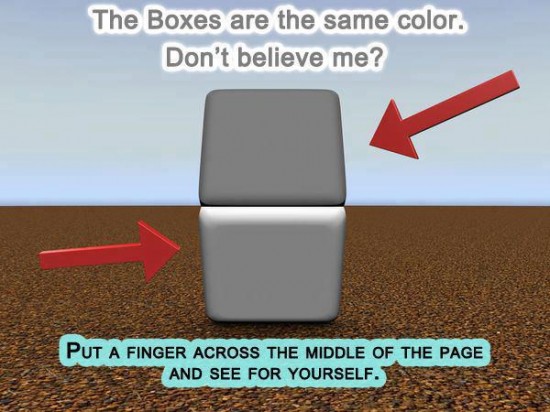I have a fondness for optical illusions and what they tell us about how our brain processes visual information. I have written before about the moon illusion and the rotating snakes.
But one of the illusions that never fails to amaze me however often I see it is the one where the squares on a checkerboard look different shades of grey even though they are the same.
For an explanation of the checkerboard illusion, see here.
Via Kevin Drum here’s another similar illusion that is as dramatic.
Try moving a horizontal finger slowly from left to right (or vice versa) across the line of separation between the two squares so that it blocks an increasing amount of the line until the line is completely blocked.


What the fuck?!?!
The tile got DARKER when she pulled it out of the shade! It changes shade halfway through the transition!
I’m not saying it’s fake, I’m saying
WHAT!
THE!
FUCK!
Does anyone know of any good books about the science of perception? I finished an evolution binge a while ago after The Selfish Gene, The Extended Phenotype, The Ancestor’s Tale, Greatest Show on Earth, and Why Evolution is True (notice a pattern, lol) and I’m looking for something new to chew on. This seems a great topic.
There are neat ways of using this kind of trick. In photographs, if you want reds to look more saturated, desaturate the whole picture (including the reds) -- somehow the brain goes “ZOMG! That’s REALLY RED!” I haven’t figured out that one but I use it all the time. 🙂
Along a very similar vein, check out these optical illusions--in which different squares are actually the same color but look like completely different hues!
http://gurneyjourney.blogspot.com/2010/01/color-constancy.html
I thought the same thing, but if you look closely, it does get darker in the shade and lighter in the light. It is easier to see at 0:57 when she does it zoomed in. Watch the line of the shadow pass over the square and resist the powerful illusion.